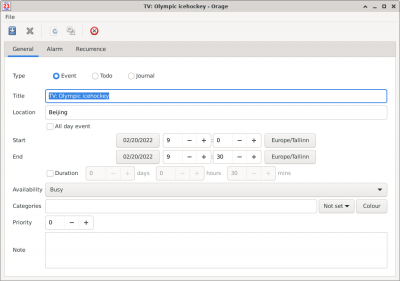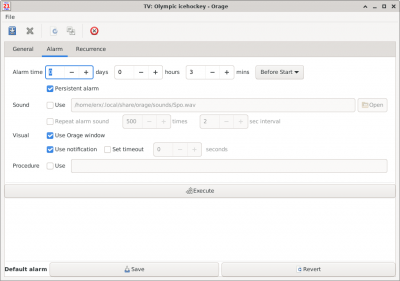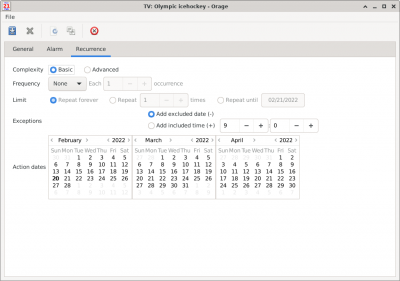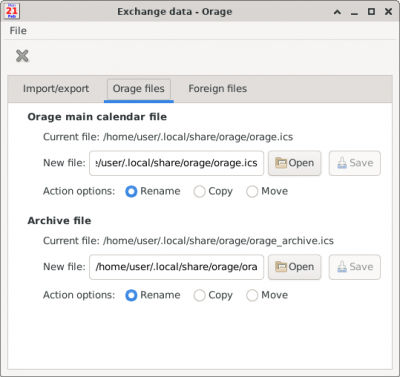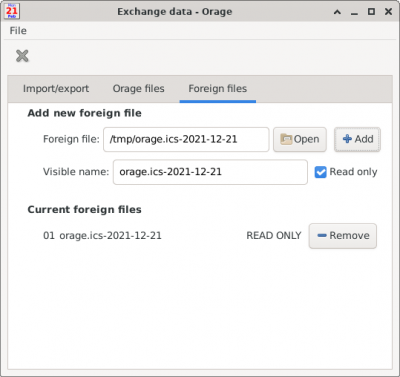This is an old revision of the document!
Orage - A calendar application
Orage is a fast and easy to use graphical time-managing application for the Xfce Desktop Environment. It uses portable ical format and includes common calendar features like repeating appointments and multiple alarming possibilities. Orage does not have group calendar features, but can only be used for single user.
| Orage Calendar |
|---|
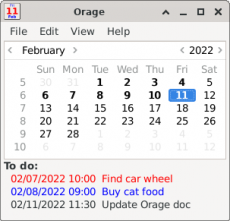
|
Features
- Runs from notification area.
- Import/Export iCal files.
- Alarms.
- View selected date/week.
- Archiving.
- Popup notification for alerts.
- Daily event listing.
Getting started
Orage is started by typing orage on the command line or in the run application window. The command line accepts some options like -v, which tells the version and -h, which shows short usage help. You can also start Orage by clicking on the “Orage Calendar” item in the “Office” submenu from the desktop menu. But usually Orage is started automatically as part of Xfce startup.
The first thing you should do is to adjust your preferences. Before adding any appointments, it is strongly recommended to set your local timezone.
| Orage menu item in the desktop menu |
|---|

|
When you run Orage, you will first see the calendar window appearing.
The calendar window
| Default Calendar Window |
|---|

|
The calendar window provides you a menu bar giving access to different functions. Below that is a standard calendar showing the month, year and day names and week numbers. At the bottom there is small window showing active TODOs and EVENTs on the selected day.
The menu bar
The menubar contains four menus: File, Edit, View and Help.
The File menu
| File menu in the calendar window |
|---|
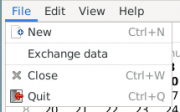
|
The File menu contains four items:
- New: open an appointment window for creating a new appointment;
- Exchange data: open a window where you can do file level operations to Orage data: 1) import and export appointments between Orage and operating system files or 2) rename Orage files or 3) add and remove foreign calendar files;
- Close: hide the calendar window but keep Orage running in the background;
- Quit: end Orage.
The Edit menu
| Edit menu in the calendar window |
|---|

|
The Edit menu gives you access to the settings window, which will be explained later.
The View menu
| View menu in the calendar window |
|---|
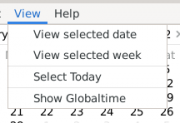
|
The View menu has four choices:
- Unordered List ItemView selected date: show the event list of currently selected date;
- View selected week: show the day window starting from current day;
- Select today: set calendar's selected day to be today;
- Start GlobalTime.
The Help menu
| Help menu in the calendar window |
|---|

|
The Help menu has also two choices:
- Unordered List ItemHelp: show this help file;
- About: show information about the version and authors and license.
The calendar
Calendar view presents you one month, which you can change by pressing the arrow beside the month name or the year number or using the mouse wheel. Days where you have appointments or where you have Ending TODOs are marked as bold. One day is always selected and shown with a block. You can change the selected day by single clicking any day number. Double clicking a day number causes event list window for that day to be activated (or day list if you changed your preferences).
The TODO list
The bottom window lists your active TODOs. You can scroll to see them all. Red means the TODO is late (due date has passed). Blue means that the TODO is active (start time has passed, but you still have time before the due time passes). And black means a future TODO. You can edit TODOs by double clicking the row. All rows have tooltips, which show more details about the TODO.
The EVENT list
Below the TODO list you see your events from the selected date. (Or from several days depending on your settings in the preferences.) Check the tooltip for more details of the event. Also events can be edited by double clicking them.
The event list window
| Orage event list window |
|---|
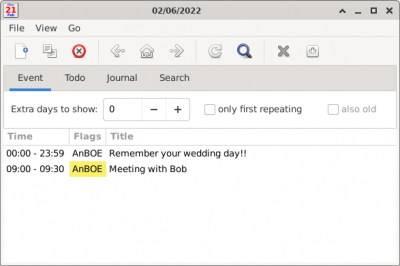
|
The event list (or appointment list as it is also called) window shows all activites that you have reserved for the day (date is shown in the window heading in your locale format). On top of the window you have menu and buttons to do actions. This is your main activity window and you may want to keep it up all the day and even make it to appear on all workspaces or to be always on top of other windows.
The button bar
There are ten activity buttons in the button bar from left to right:
- New: start an appointment window for creating a new appointment for this day;
- Duplicate: also start an appointment window for creating a new appointment for this day. But do not start from scratch, but copy all values from the active row in the appointment list below. Note that if you do not have any rows selected from the event list, this button does not do anything (but gives a warning);
- Delete: remove all selected appointments. There is no undo, so be carefull with this button! Before removing anything Orage asks for your verification.
- Back: show previous day;
- Today: show today;
- Forward: show next day;
- Refresh: redisplay this date;
- Find: activate the search tab;
- Close: close this window;
- Dayview: start day list window;
The tabs
Each of the four tabs selects the type of appointments to show. There may also be extra selections possible depending on the tab. You can select tab by clicking it or by using the mouse wheel. Let's check each tab:
- Event: the event tab shows all EVENT type appointments happening on this day. It is possible to see more than one day in this tab by setting “Extra days to show” number to larger than 0. (You can change the default 0 in the preferences dialog.) Each number shows one more day. (It causes the Time column in the event listing to show also the date.)
- Todo: shows your active TODOs similarly than in the main calendar window. Only active ones are shown. If you want to see old TODOs, you need to find them in Search tab.
- Journal: lists your notebook entries starting from certain date. Default start date is one year back and you can not change the default setting.
- Search: enter a free text, which is searched from all the appointments. Usually the search is case independent, but for some utf8 characters Orage switches to case sensitive search method. This happens if the length of the string is different in upper case compared to lower case (for example German language double s causes this).
The appointment list
The list shows all appointments satisfying the conditions and tab type. Scrollbars will appear if there are more lines or longer lines than what fits into the window. You can edit any appointment by double clicking the row. Each line has three fields:
- Time: the starting and ending times of the appointment (the format varies depending on tab and appointment). All times are always shown in your local timezone. It is possible to define special whole day appointments and they have a text “All day” instead of real start and end times. Rows appear in start time order. +sign in front of the time means that the appointment started on some previous day and correspondingly +sign at the end of the time means that appointment continues and ends later than the selected day. If the Event tab shows today, there are few extra formattings used: When the event has passed, it is overstriked. Currently active events are shown with blue colour and future events are bold.
- Flags: gives information about the appointment. If your appointment has a category which has been associated with a clour, flags field has that colour background. (Note that the explanations are visible as a hint when you move your cursor into the appointment list.) There are five flags in order:
- Alarm: what kind of action happens when alarm time passes. n means no alarm has been defined. A means that visible window is raised. S means that sound is played. (If both visual and sound alarm is defined, S is shown)
- Recurrence: how often is that appointment happening. n means no repeating so that this event only happens once. D means daily repeat, W weekly, M monthly and Y yearly.
- Type: what kind of reservation is this. Two options: f means free so that the action is not reserving the time and it is possible to schedule more appointments at the same time and respectively B means busy, so that nothing else can be done at this time. Note that current version of Orage does not enforce these and the flag is only as a comment (in the future this may be enforced).
- File: where this appointment is stored. O means it is in the standard active Orage file, A in the archive file. (The appointment is automatically unarchived if it is edited.). Archived appointments can only be found in the Search and Journal tabs. F appointment is in foreign file; in other words it is not native Orage appointment.
- Appointment type: E for EVENT, T for TODO and J for JOURNAL. This flag is usefull only in search tab since the tab name informs the type in other tabs.
- Title: the heading of the appointment. Note that the whole title is shown, so you may want to avoid using too long titles to keep the view cleaner.
The day list window
| Orage day list window |
|---|

|
The day list window shows all events that you have reserved for the next days. Default is to show 7 days, but you can change that and see up to 40 days at once. On top of the window you have menu and buttons to do actions. This is another form of your main activity window and more usefull than event list window if you want to find room for your new events or see your agenda and free time from longer perod than one day.
The button bar
here are six activity buttons in the button bar from left to right:
- New: start an appointment window for creating a new appointment for this day;
- Back: start listing one day earlier;
- Today: change start day to be today;
- Forward: start listing one day later;
- Refresh: redisplay the window;
- Close: close this window;
The parameters
Below the buttonbar are the two settings. You can change the start day of the day list and the number of days shown.
The day list
Biggest part of the window is the day list area. You can click the header of the day to open event list window for that day. First line contains full day events when defined. The other lines contain events that you have scheduled. Each event has tooltip which include appointment details. You can update the event by double clicking it. Events are placed on the start time row and even if the length is several hours, the event is only visible on single row. If the event is taking time (availability=Busy), there is vertical line in front of it showing its length. These lines show how full your calendar is and makes it easier to find free time quickly. If more than one event starts at the same hour, they all are added to the same row / column after each other and the reservation line is the overlap of them.
The appointment window
The appointment window is used to add, edit and delete appointments. It is the most complex window in Orage, but most fields still have good default values and are not mandatory. It has button bar (All actions are also available in menus above the buttons) and three tabs controlling basic settings and alarms and recurrence settings.
The button bar
There are 5 activity buttons in the button bar from left to right:
- Save: store the appointment to the Orage system. This causes also data validity checking.
- Save and close: like Save, but also closes the window.
- Revert: undo all changes done after previous save. Note that this button is active only after data has been changed.
- Duplicate: start creating new appointment and copy all values from the current activity into it. The new appointment is not created until you press Save.
- Delete: remove current appointment permanently from orage system.
The general tab
The alarm tab
The recurrence tab
The exchange data window
The import export tab
The orage files tab
The foreign files tab
The preferences window
The preferences window is used to enter initial values for Orage. You can define for example several display options, how old appointments should be archived and what is the command to be used for playing sound alarms and also you can set the local timezone for Orage.
The main tab
| Orage preferences window - main tab |
|---|
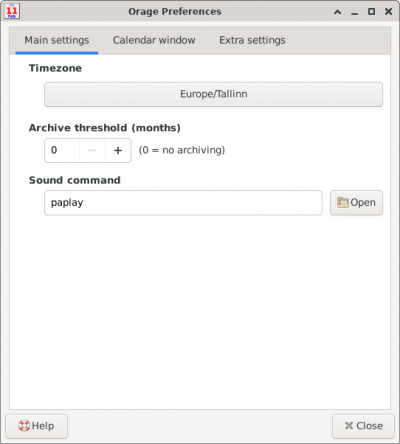
|
Timezone
You should always set the default timezone for Orage. It is possible to use also floating times, but then all times should be in floating form. It is a bad idea to mix floating and timezone times. Floating times tend to move to follow any timezones they see…
Archive threshold
Orage does not delete appointments automatically, so usually your calendar file grows bigger and because of that Orage gets slower and takes up more memory from the system. Enabling automatic archiving causes old appointments to be moved from the active calendar file to passive history file after the selected time. This helps to keep the active file smaller and the application in good shape. Archiving is enabled by setting the threshold to other than 0 value. Of course it is also possible to manually delete appointments, but that removes them permanently and you will not be able to find them later.
Note that Orage also splits recurring appointments so that if the original start date is older than threshold, that appointment is added to the archive file and the starting date in the active calendar file is updated to contain only values more recent than the threshold. This also saves time when Orage is searching recurrent events.
Sound command
Here you can define which sound command Orage uses when playing sound files. Try testing some common commands like play or aplay from terminal to see what works on your system. You probably do not want to use full version of Totem or MPlayer since they will cause a video window also to appear and that most probably is not what you want.
Basically it is possible to do other than sound commands also since Orage really only starts this program and gives it the sound file as parameter. But this is not the intention of this feature.
Calendar window tab
| Orage preferences window - calender window tab |
|---|

|
In this tab you can define visibility options for the main window of Orage.
Show borders
You can hide window borders and make the calendar window smaller by unselecting this option. This frees more space to your other applications from your workspace.
Show day names
Controls day names visibility on top of the calendar window.
Show month and year
Select whether you want to see month and year controls in the main calendar window.
Show menu
By unselecting this you can leave out the menubar in the top of the calendar window.
Show week numbers
Controls visibility of week numbers on left of calendar.
Show todo list
You can hide TODO list in the main calendar by deselecting this.
Number of days to show in event window
You can hide EVENT list in the main calendar by setting this to zero. Non zero values means the number of days to show events for.
Show on all desktops
Show calendar window on all workspaces by selecting this.
Keep on top
Keep calendar window on top of all other windows.
Show in taskbar
Controls if calendar is visible in the taskbar.
Show in pager
Controls if calendar is visible in the pager.
Show in systray
Controls if calendar is visible in the systray. A small icon is presented in the systray if this is selected. It is recommended that you enable this feature. By clicking this icon Orage is toggled visible or hidden. If you do not have Orage in the systray, you can make the main calendar window visible again by start Orage again.
Calendar start
It is possible to define that Orage starts in the background or as minimized. This option only affects the start of Orage.
On calendar window open
If calendar is opened then set selected day to today's date or last selected date.
Calendar day double click shows
On double click open days view window or event list.
Calendar extra tab
| Orage preferences window - extra tab |
|---|
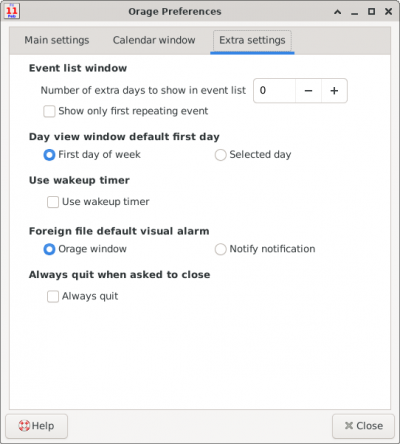
|
Event list window
Define how many days to show in the event list when it starts. (It is possible to change the number in the event list window.)
Day view window default first day
Set day view window first day either first day of week or selected day.
Use wakeup timer
Use this timer if Orage has problems waking up properly after suspend or hibernate. For example tray icon not refreshed or alarms not firing.
Always quit when asked to close
By default Orage stays open in the background when asked to close. This option changes Orage to quit and never stay in background when it is asked to close.
Dependencies
For compiling Orage, you will need the GTK (>= 3.24.0) libraries and header files. You will also need its dependency libraries and header files, such as Pango, Cairo and Glib.
Furthermore you need, of course, a C compiler.
Required dependecies:
- Xfce development tools 4.16.0 or newer
- GTK 3.24.0 or newer
- GLib 2.52.0 or newer
- intltool 0.35 or newer
Optional dependencies:
- Libical 3.0 or newer
- D-Bus 0.1 or newer
- Libnotify 0.3.2 or newer
Latest Release
- orage 4.21.0 released (2025/10/20 07:53)orage 4.21.0 is now available for download from https://archive.xfce.org/src/apps/orage/4.21/orage-4.21.0.tar.xz https://archive.xfce.org/src/apps/orage/4.21/orage-4.21.0.tar.xz?sha1 https://archive.xfce.org/src/apps/orage/4.21/orage-4.21.0.tar.xz?sha256 What is orage? ============== Orage is a time-managing application for the Xfce desktop environment Website: https://docs.xfce.org/apps/orage/start Release notes for 4.21.0 ======================== [Please note that this is a development release.] Development release on the master branch. The detailed changes are: - New Orage main window layout (MR !80, Issue #18). - Revised CSS element naming for consistency. - Replaced Autotools with Meson (MR !74 and MR !77). - Added ICAL file preview and import dialog (MR !75).
Source Code Repository
Reporting Bugs
- Reporting Bugs – Open bug reports and how to report new bugs

